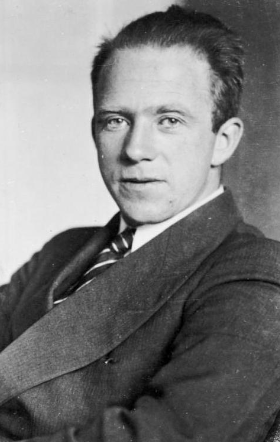Werner Heisenberg (1901-1976) is a prominent German theoretical physicist and one of the significant founders and pioneers of quantum mechanics. In 1932, he was awarded the Nobel Prize in Physics for the creation of quantum mechanics, the application of which has, among other things, led to the discovery of the allotropic forms of hydrogen. He is mainly known for formulating the Heisenberg uncertainty principle, a fundamental concept in quantum mechanics.
An Introduction to the Heisenberg Uncertainty Principle
Classical physics tells us that objects have specific positions and momentums and move by particular trajectories. However, this is not applicable in the quantum world. To say it more precisely, the Heisenberg Uncertainty Principle points out that we cannot simultaneously measure the position and momentum of an object. Uncertainty is universal for all matter, whether microscopic or macroscopic. The more accurately one property is measured, the less accurately the other can be known. We think macroscopic objects are against this principle only because their uncertainty is low.
In 1926, Heisenberg came up with the mathematical formula for the relationship between the uncertainty of position (△x) and the uncertainty of momentum (△P):
We can infer from the formula that
which corresponds with its verbal description. For detailed proof of Heisenberg’s Principle, please watch this video. Let us look at an experiment to further understand the Heisenberg Uncertainty Principle.
The Double-Slit Experiment
The double-slit experiment is one of the most famous experiments evidencing quantum mechanics' fundamentally probabilistic nature. It is also a simple demonstration of wave and particle duality. In this experiment, we use a light source (either photon or electron beam gun) to shine on a metal plate with two slits. Electrons travel through the double-slit and are displayed on the projector screen. Unexpectedly, we do not see one light spot cut in half by the double-slit. Instead, a broad band of light stripes has been displayed on the screen, a typical result of the interference of two waves.
What is uncertain in this experiment? The slit that the electrons pass through (slit identity) and their position on the screen (screen position). Now, we see a specific relationship between the uncertainty of the double-slit experiment and the Heisenberg Uncertainty Principle: one electron’s initial position is represented by slit identity, and its momentum, as a vector that contains direction, is represented by screen position. When we measure the slit identity and screen position of one electron individually, we cannot determine the exact value of the other.
Measurement of Slit Identity
To measure the slit identity of electrons, we can replace the screen with an array of electron detectors, each of which points at just one slit, as shown in experiment (a). Given the nature that electrons could hit the same position from either of the slits, there should be a pair of detectors at every screen position, each pointing at a different slit. Adopting this imaginary apparatus, we could find that the distribution of electrons is a diffraction envelope, the same result of a single-slit experiment. Here, we make a precise measurement of the slit identity (either from slit 1 or slit 2) as well as the position of electrons, but we only get a wave function of their screen positions, in other words, we do not know the momentum of electrons accurately. Any reduction in the uncertainty in position increases uncertainty in momentum.
Measurement of Screen Position
The measurement of screen position is how the original experiment works. Its result is the interference structure, a more accurate position description than the diffraction envelope. In the standard double-slit experiment, we do not measure the slit identity, or to say it worse, we just do not know where the electrons are coming from. Do they pass one slit or both at once? It remains uncertain. Well, the magic of the Heisenberg Uncertainty Principle ensures that, since x is large, P will be extremely small, roughly equal to the distance between successive maxima in the interference pattern.
The Heisenberg Uncertainty Principle is implemented to explain the credibility of wave and particle duality. Based on the most accurate interference structure we get, humans can delve deeper into the probabilistic nature of quantum mechanics.
Works Cited
Chapter 14 Interference and Diffraction. (n.d.). Available at: https://web.mit.edu/8.02t/www/802TEAL3D/visualizations/coursenotes/modules/guide14.pdf
Chemistry LibreTexts. (2014). 1.9: The Heisenberg Uncertainty Principle. [online] Available at: https://chem.libretexts.org/Bookshelves/Physical_and_Theoretical_Chemistry_Textbook_Maps/Physical_Chemistry_(LibreTexts)/01%3A_The_Dawn_of_the_Quantum_Theory/1.09%3A_The_Heisenberg_Uncertainty_Principle [Accessed 26 Dec. 2023].
Collinsdictionary.com. (2023). Definition of inter alia. [online] Available at: https://www.collinsdictionary.com/dictionary/english/inter-alia [Accessed 26 Dec. 2023].
Nature Noon. (2021). Double Slit Experiment: 10 Steps Explanation (Plain English). [online] Available at: https://naturenoon.com/double-slit-experiment-simple/ [Accessed 27 Dec. 2023].
Nist.gov. (2018). CODATA Value: Planck constant. [online] Available at: https://physics.nist.gov/cgi-bin/cuu/Value?h [Accessed 26 Dec. 2023].
Stone, J. (2021). Quantum Mechanics and the Famous Double-slit Experiment. [online] Physics Forums Insights. Available at: https://www.physicsforums.com/insights/quantum-mechanics-and-the-famous-double-slit-experiment/#Heisenbergs-Uncertainty-Principle [Accessed 27 Dec. 2023].
Stone, J.V. (2020). Dr James V Stone - The Quantum Menagerie. [online] Sheffield.ac.uk. Available at: https://jamesstone.sites.sheffield.ac.uk/books/the-quantum-menagerie [Accessed 27 Dec. 2023].
NobelPrize.org. (2023). The Nobel Prize in Physics 1932. [online] Available at: https://www.nobelprize.org/prizes/physics/1932/heisenberg/facts/ [Accessed 26 Dec. 2023].
does, M. (2020). The Heisenberg uncertainty principle || Proof. YouTube. Available at: https://www.youtube.com/watch?v=fsC5Mhd7YUc&ab_channel=ProfessorMdoesScience [Accessed 26 Dec. 2023].
.png)






Comments